Trip Log - Achray to Carcajou Lake via Carcajou Creek and Return
An account of a five day canoe trip out of Achray to Carcajou Lake and return. We wanted to check out the old logging dam between Wenda Lake and Carcajou Lake to determine if this was the location of the Tom Thomson painting "The Drive". In addition there are two other Tom Thomson sketches, "In Petawawa Gorges, Spring" and "Algonquin Park Vista", that we suspected also might lie up that way.
We also wanted to test out some changes to our tripping routine — our food strategy and the resurrection of our 42 year old tent. Both experiments were highly successful.
Our route was Achray to Little Carcajou Lake via Carcajou Bay, and Upper and Lower Spectacle Lakes. We travelled to Carcajou Lake via Carcajou Creek, passing through Wenda Lake. We visited the sedge meadow on Carcajou Creek as a day trip. We returned to Achray as we came with a slight detour to visit Stone Chute where Carcajou Creek exits Little Carcajou Lake. We encountered only one other couple in our travels beyond the Spectacle Lakes.
The text below is a minimally edited transcription of our trip diary. On this trip, the diary was written completely by Bob. However, Diana has subsequently added some comments; these are identified. Any material added subsequent to the trip is enclosed in square brackets.
2015 June 21 (Sunday) - Achray to Little Carcajou Lake
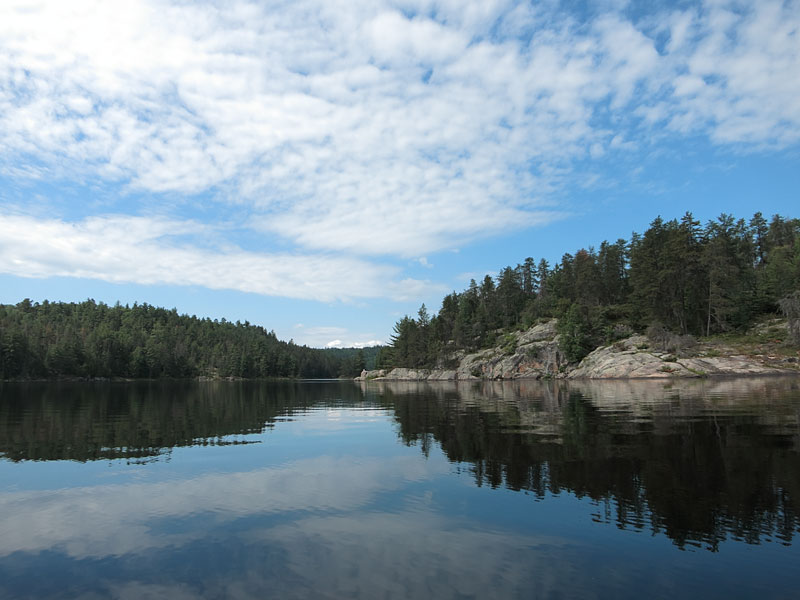
(photo by Diana: 2015-06-21 - map - explore)
Mouth of Carcajou Bay on Grand Lake.
Just finishing our snack break – 11:11 in the mouth of Carcajou Bay, heading for Little Carcajou. Left Achray @ 10:30, house @ 8:35. Weather is calm with high thin cloud but showers and T-storm expected later.
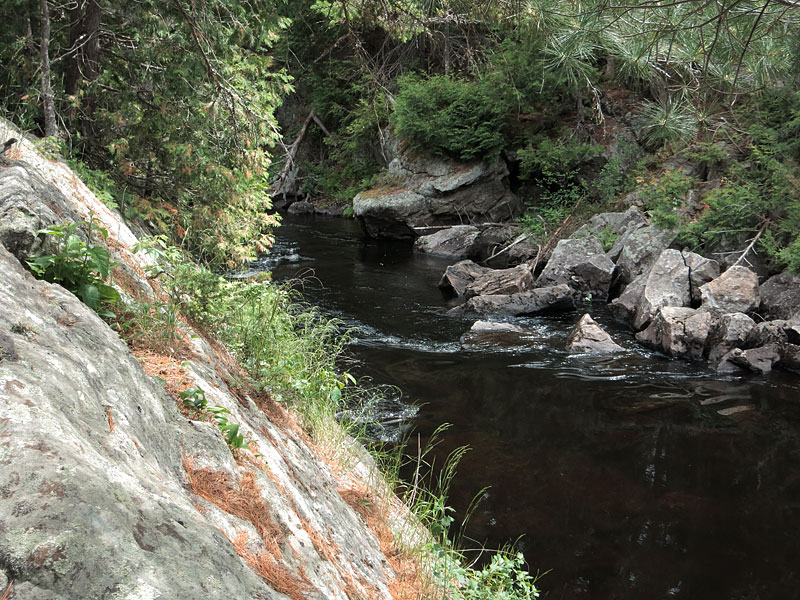
(photo by Diana: 2015-06-21 - map - explore)
At the rocky lift-over near the top of Carcajou Bay. In our view, "just doing it" — i.e., unloading the canoe and lifting it over — is easier than trying to line up at this water level.
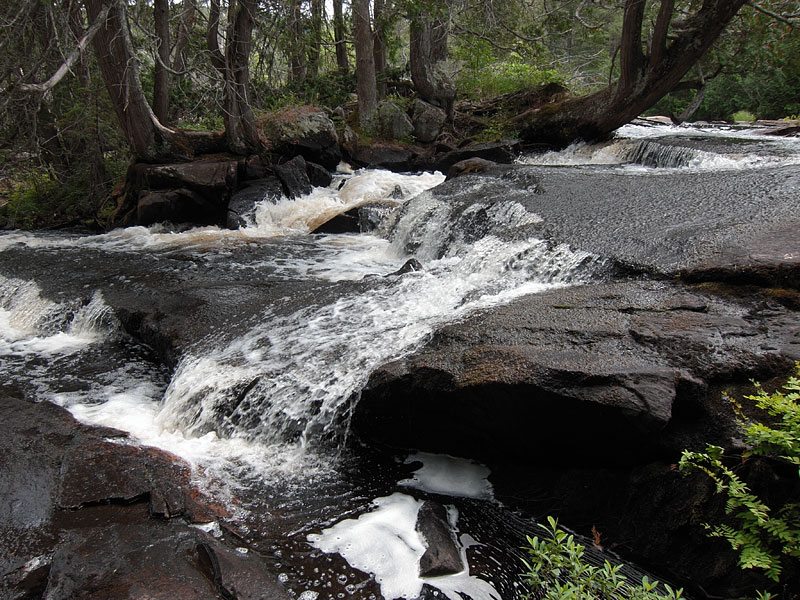
(photo by Bob: 2015-06-21 - map - explore)
Carcajou Falls (official name is High Falls, but there are too many "High Falls" in Algonquin Park.) It is a complicated falls; this is the western channel of the lower drop.
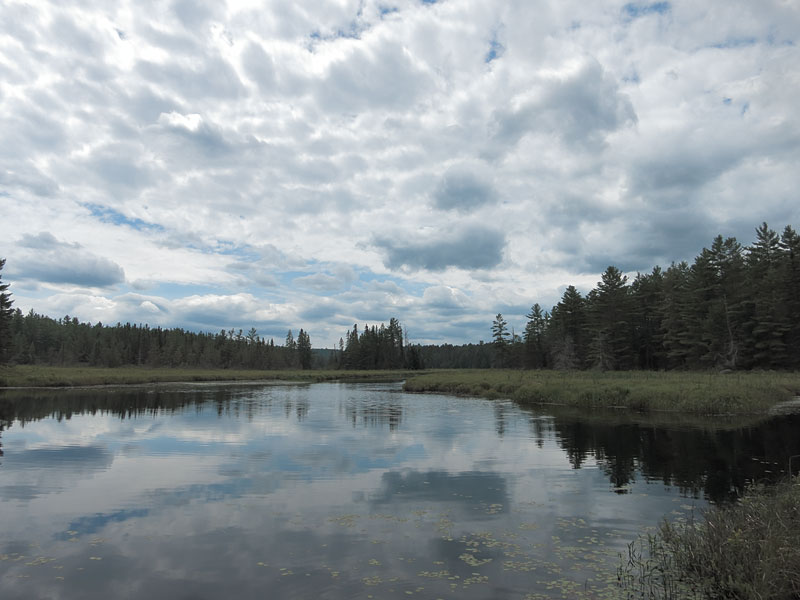
(photo by Diana: 2015-06-21 - map - explore)
Looking up Carcajou Creek from the end of the portage around the top part of Carcajou Falls. However, our route was to the right, through the rocky gut into Lower Spectacle Lake.
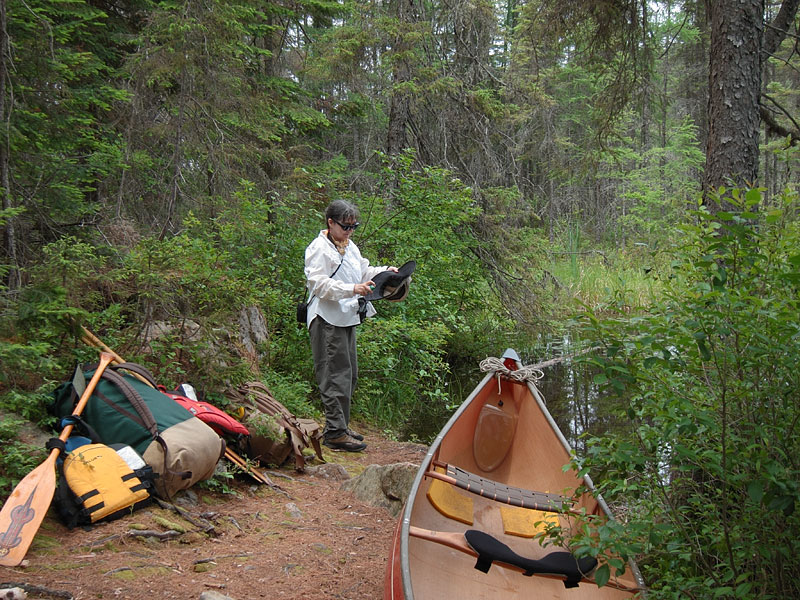
(photo by Bob: 2015-06-21 - map - explore)
Diana applying bug spray to her hat at the end of the portage into Upper Spectacle Lake. There were bugs, but they weren't a major issue. (We think the bugs were light this year; others may differ.)
When we arrived at the [only] camp site on Little Carcajou [which we had reserved] it was occupied. An inexperienced couple who had a reservation for the cabin were [set up] there. [We had interrupted their skinny dip]. They were on their second day of travelling [to the cabin], having spent the previous night camped on the portage [at the beaver pond]. They [immediately and without argument] volunteered to move on, but in retrospect, it might [would] have been better if we had travelled on and camped at the cabin.
[Diana: I didn't feel too bad about them packing up and moving on, since they had had some rest already and were heading for a cabin and would not have to do a full set-up when they got there. Also, it is not that bad a trip from Little Carcajou to Wenda, and, being the solstice, there would be more than enough light. I lay down in the bushes and had a nap while waiting.]
They were finally clear of the camp site by about 6:30.
The wind was blasting and I had a hell of a time putting up the tarp. It seems that the secret is to tie off the down wind points first.
We had coffee, snacks and a cup of soup. We considered skipping supper but I ran out of my day's ration of snacks [and was still hungry], so we decided to have some Mountain House freeze dried lasagna.
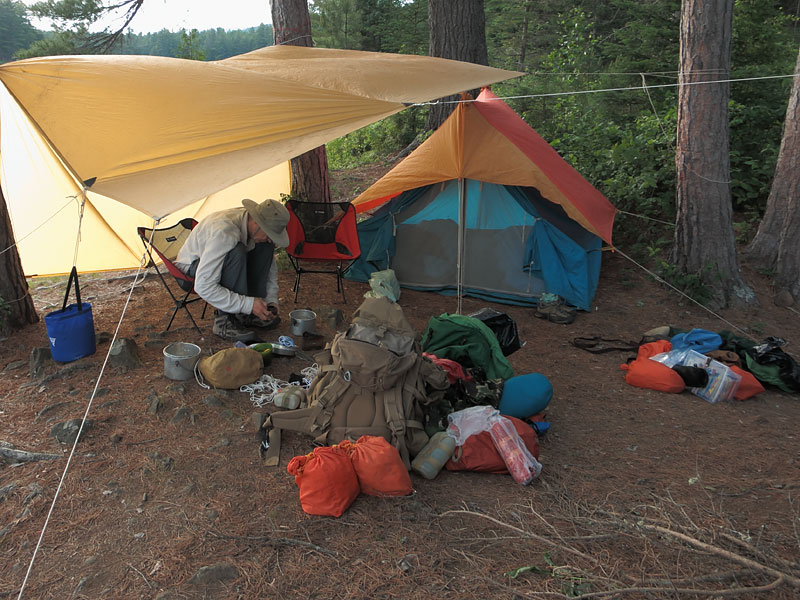
(photo by Diana: 2015-06-21 - map - explore)
Our Taymor 3-man hunter tent set up on Little Carcajou Lake (see This Old Tent — A three-man Taymor 'Hunter'). This is the first time this tent has been out on a trip in perhaps 30 years. Diana was convinced that this was a better tent for the bug season than our MEC Wanderer 2. On the basis of this trip (compared to last year's trip) we both agree that she is correct — Diana especially. It has more interior space, it is easier to get in and out of without letting the bugs in, it doesn't have an enclosed vestibule that provides the bugs with a protected haven and it weighs about the same. It is more "open" to the environment while still providing adequate protection.
Here, the tarp and tent are up and Bob is making coffee; everything else is in disarray.
The wind has now (8:20) died and it is still and humid. The bugs are out. We set up the bug net under the tarp – a bit of a jury rig but effective.
Into the tent for the night at around 10:00 pm – pretty late for us.
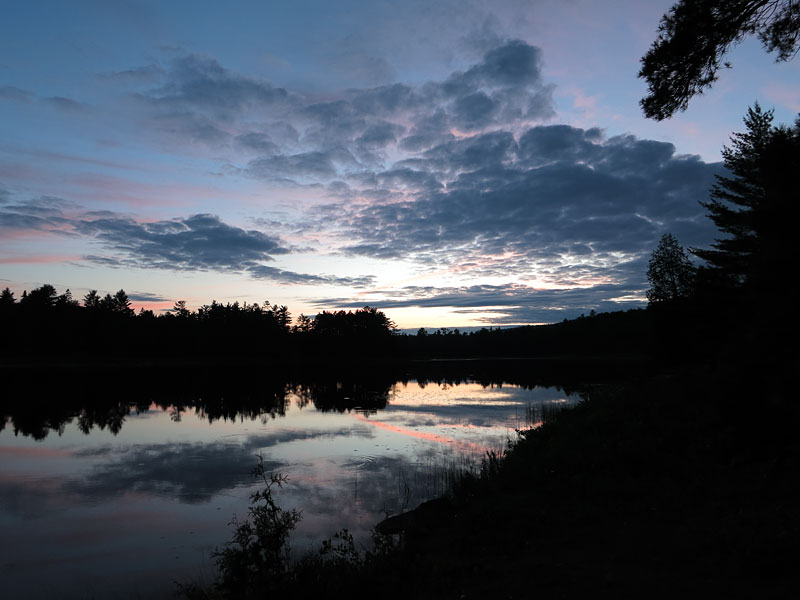
(photo by Diana: 2015-06-21 - map - explore)
Sunset on Little Carcajou Lake.
2015 June 22 (Monday) - Little Carcajou Lake to Carcajou Lake
Quiet night – if you don't count the bullfrogs. Diana heard an owl. I heard some “snorting” during night – perhaps a deer. Starting to get light at about 4:30. In Diana's words, “Ah, the beautiful sound of the red breasted robin at four fucking thirty in the morning!”
[Diana: I feel I've been misquoted here – I said “song” not “sound”. On top of the numerous and very loud bullfrogs who were grunting enthusiastically all night, the birds tuning up at dawn were a bit much. Not a great night's sleep.]
We're sitting in the bug shelter having coffee at 6:35. The day is calm, the sun is shining and the bugs are out.
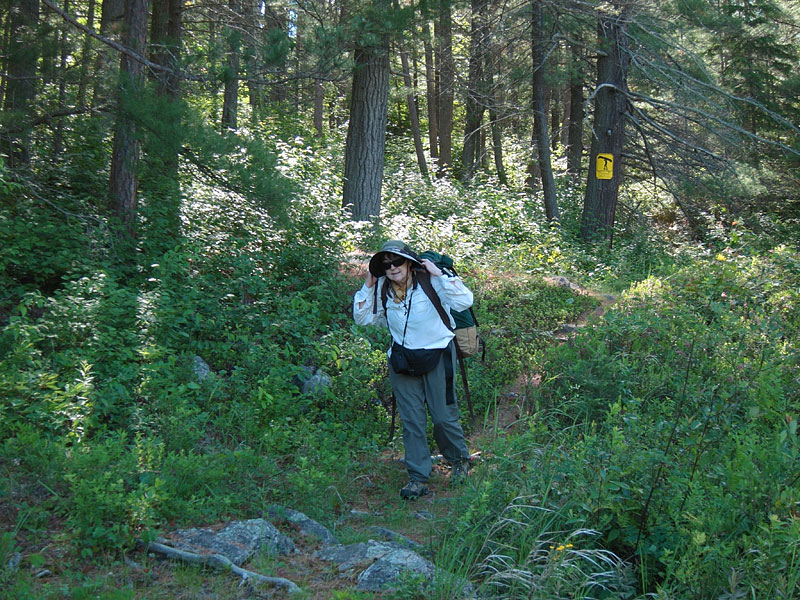
(photo by Bob: 2015-06-22 - map - explore)
Portaging between Little Carcajou Lake and Wenda Lake.
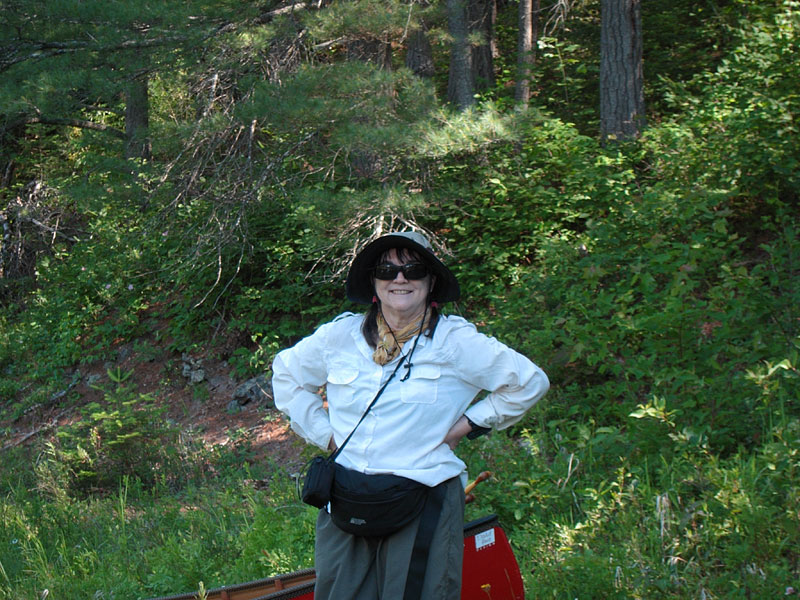
(photo by Bob: 2015-06-22 - map - explore)
At the end of the portqge into Wenda Lake.
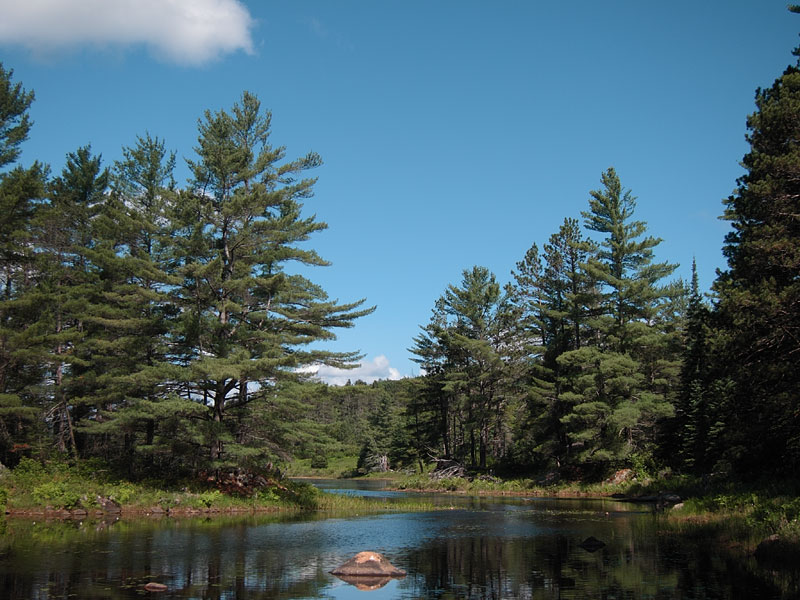
(photo by Bob: 2015-06-22 - map - explore)
Looking towards Wenda Lake from the end of the portage. There are two rock-stuffed beaver dams between here and Wenda Lake and not enough water to paddle over them.
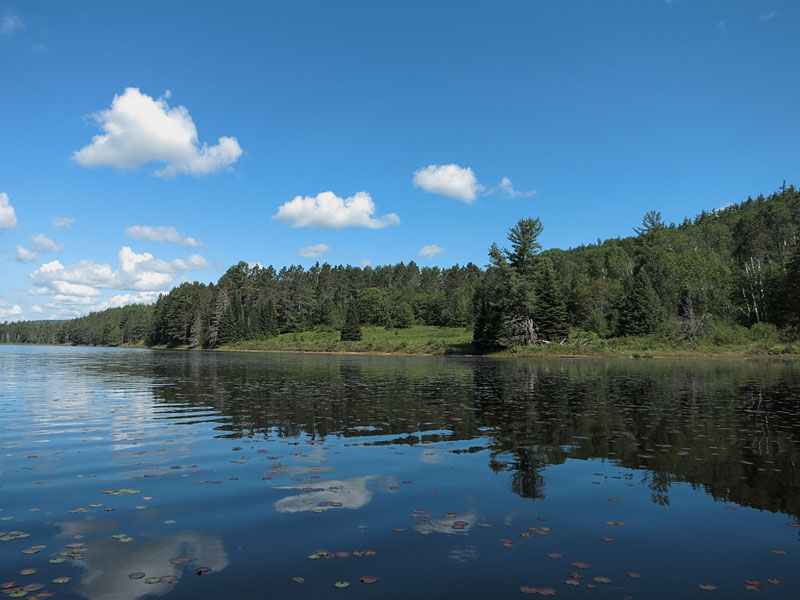
(photo by Diana: 2015-06-22 - map - explore)
Wenda Lake. The open area on the shore appears to have once been the site of a logging camp. The cabin is in the trees just beyond it.
11:15 Sitting in the canoe finishing our snack break in the creek just above Wenda Lake. We got away from our campsite on Little Carcajou at 9:30. We stopped at the cabin to return the fishing rod that the couple we displaced had left behind. We had a long chat [at the end of which, we had serious concerns about whether they were going to be able to make it out all right without assistance. But that potential problem was several days in the future.]
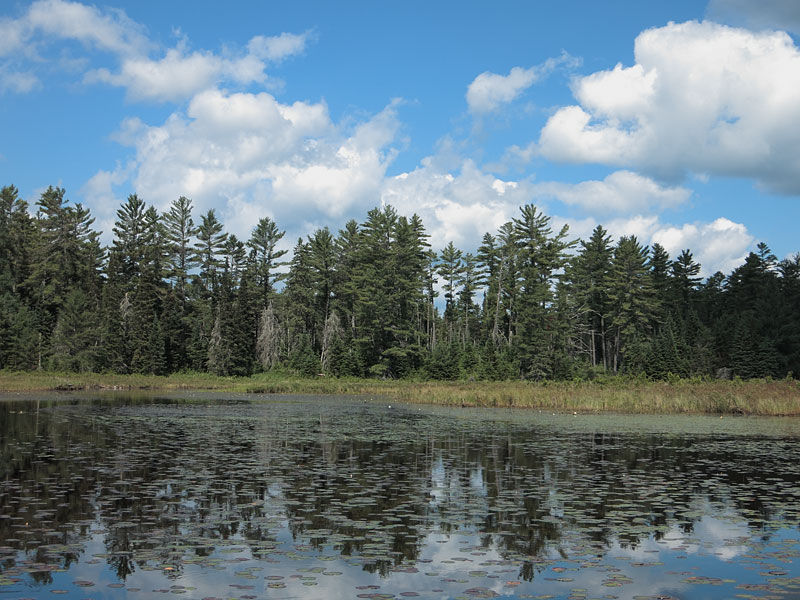
(photo by Diana: 2015-06-22 - map - explore)
The mouth of Carcajou Creek into Wenda Lake.
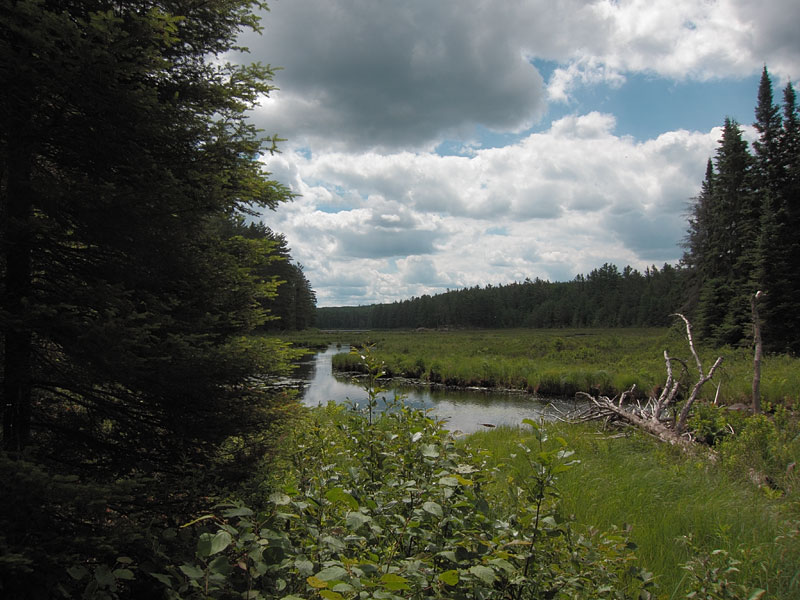
(photo by Bob: 2015-06-22 - map - explore)
Carcajou Creek above Wenda Lake.
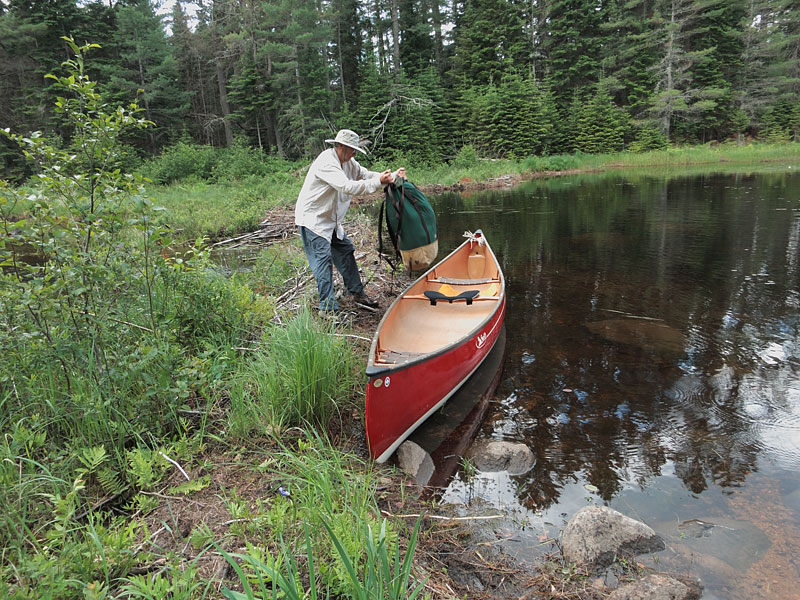
(photo by Diana: 2015-06-22 - map - explore)
Loading the canoe on Carcajou Creek. The landings for most of the portages along the creek were shallow with lots of rocky obstructions. The shore was often covered with poison ivy. Here, we are taking advantage of a beaver dam.
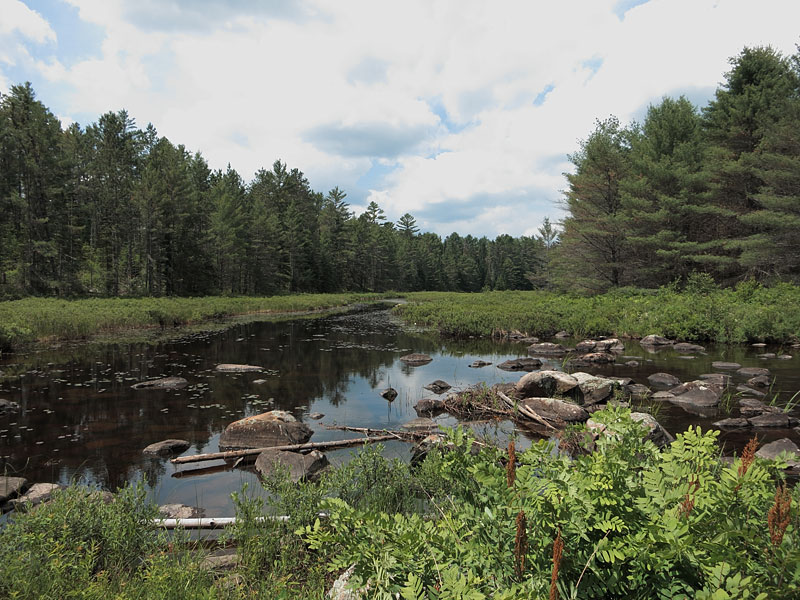
(photo by Diana: 2015-06-22 - map - explore)
A typical portage landing along Carcajou Creek.
We stopped for lunch at ~1:00 at the top of the 110m portage (with the big rock and old rock dam). It seems possible that this is the site of the Tom Thomson painting The Drive. The background hill sort of matches but if so, once again Tom Thomson is exaggerating the verticals. But the forest cover has changed so much (and the dam is gone) that one cannot match the painting. [We will give this site a more thorough investigation on our return.] It is now 1:30. Diana is pumping water and we will soon be moving on. Got away at 1:45.
It is quite hot and the water levels are getting low. [There were] several places where we had to exit the canoe and pull over. We weren't able to skip any of the marked portages but we skipped at least one of the unofficial portages. We had concerns about [finding] the last portage into Carcajou Lake. The creek had become sufficiently obstructed that we suspected that we had missed the takeout. But pressing on and pulling the canoe over a couple of logs straddling the creek we eventually reached it.
There is lots of poison ivy throughout this area, but at the Carcajou Lake end of the last portage there is nowhere to put your packs and canoe down that isn't in poison ivy.
We reached Carcajou Lake a little after 3:00. We checked out the high rocky site on the south shore – we stayed there 30+ years ago. But instead we opted for the first site on the north shore. [Softer ground and more sheltered; less beaten to death.] Set up the tarp with bug shelter. Again very windy when setting it up.
Had coffee, snacks, soup etc. at a very leisurely pace. We are both quite tired. The route is rough, but is it that rough? Or is it just our years catching up with us?
Southwestern style masa with beef by Alpinaire for supper. We'll see how that goes. I liked the dinner; Diana thought it a bit spicy.
8:37 – Last night at this time we were eating dinner. Tonight everything is put away and we are about to enjoy our Bushmills to the hum of the mosquitoes outside the bug net. Saw a deer across the way in the marsh, the same as the last time we were here 30+ years ago.
2015 June 23 (Tuesday) - Rest Day on Carcajou Lake
It rained during the night; not hard, but steady. Slept in this morning, out of the tent a little after seven. Broken cloud with sun, but also a few spits of rain. Wind out of the east. Just finishing coffee at 8:00am.
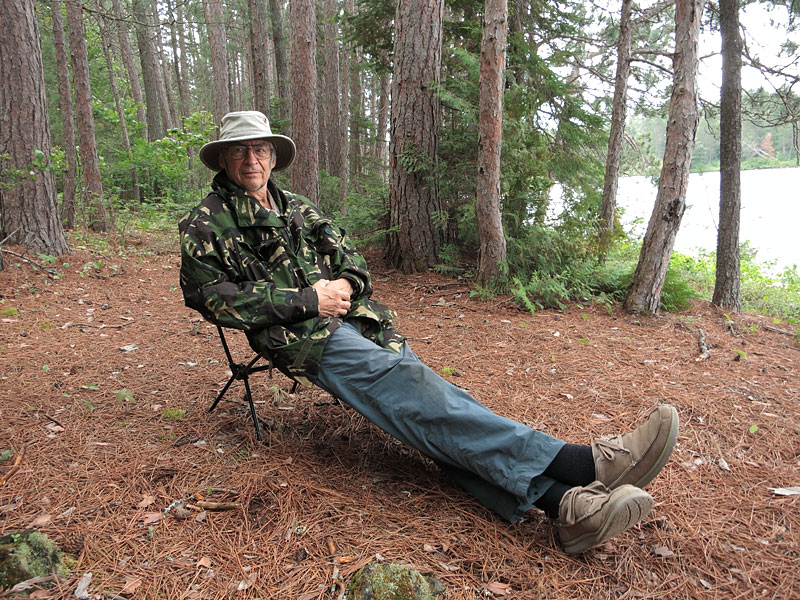
(photo by Diana: 2015-06-23 - map - explore)
Bob relaxing on Carcajou Lake. Love those Helinox chairs!
A wild day. Sunny with clouds but very windy. We think it is shifting to the west – which is good, not only as a portent of high pressure but also, that is the direction our tarp was optimized for.
It is now about 1:30. We have spent the morning sitting around, lying around, snoozing. The wind continues unabated, periodically reaching some impressive crescendos. It started to spit a little which motivated me to check that everything was storm ready! I put on a heavier shirt, my work pants and watch cap, in addition to my smock, as I was starting to feel a little chilled.
[Diana: given the wind, I was just as glad we had not taken the rock camp site, and were in a more sheltered spot. I put on my long underwear and down jacket to keep warm in the wind. Nice that the wind cut down the bugs a bit, though.]
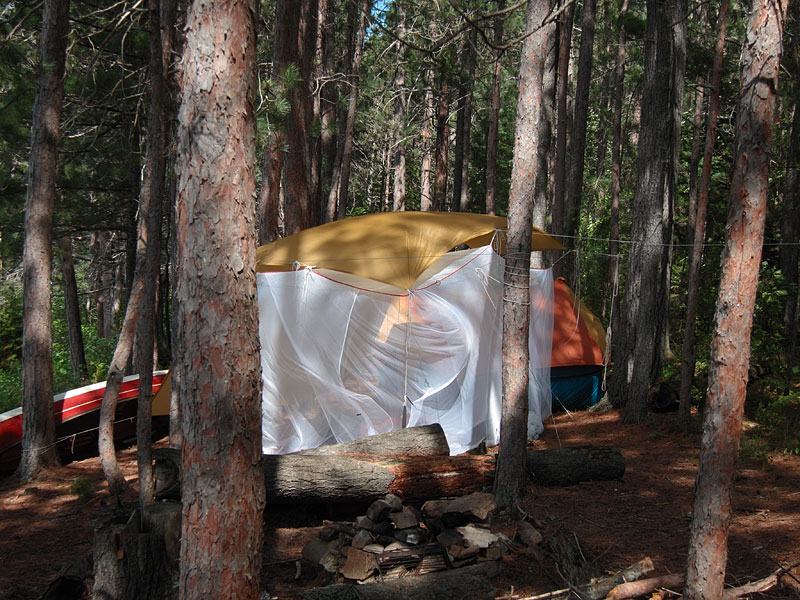
(photo by Bob: 2015-06-23 - map - explore)
Bug net blowing in the wind on Carcajou Lake.
The wind continued but died somewhat in the late afternoon. It is now 7:45 and we are ready for the night. About to serve our Bushmills. Not much to report on observations today. We haven't seen anyone since the couple at the cabin on Wenda. Saw a (the?) deer again in the swamp across the bay and a large light coloured bird. It was perhaps a gull but it was behaving more as a raptor.
There is an old overgrown road paralleling the lake shore behind this camp site. (It is shown on Jeff's map). We followed it to the eastern end where there must have been some sort of lumber camp. Not much to see now except an overgrowing clearing, some wolf trees and a few scraps of rusted metal. We also found a partially buried, rotting wood pile that I remember being offended by 30 years ago. If you're going to log in the park, fine, but if you cut it, haul it out!
[Diana: west of the camp site the old road turns north and ends up at the westernmost camp site on Grand Lake. Supper was home made (minute rice, soup mix, dried onions, some seasoning, bacon bits) – fairly tasty, if a bit bland, and went down well.]
2015 June 24 (Wednesday) - Exploring the Sedge Meadow upstream of Carcajou Lake
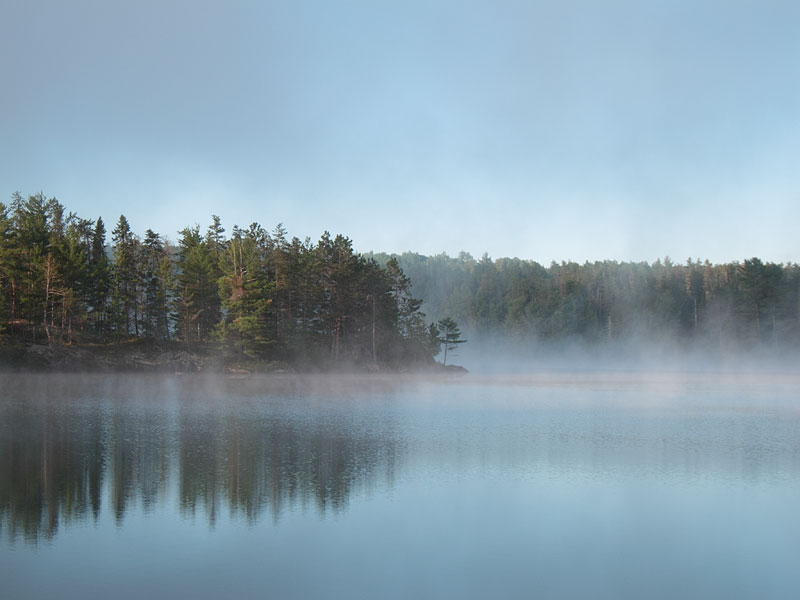
(photo by Bob: 2015-06-24 - map - explore)
Morning mist on Carcajou Lake.
7:00 am. Sitting snug in our bug net enjoying our morning coffee – clear, mist on water, ~8C. Quiet night, beautiful morning.
(Notes: we need to bring extra coffee, especially for rest days; we need to replace the filter element in the water filter; Bob lost a button on his smock. Need to check/reinforce the remaining buttons; need to restore shoelaces in repair kit;)
... back to our story ...
8:55, in the sun, in our canoe, just off our camp site and about to go exploring. We paddled up the lake with the intent of exploring the sedge meadow. We were interested in the sedge meadow for its own sake, but we also thought it was a possible location of the Tom Thomson sketch Algonquin Park Vista.
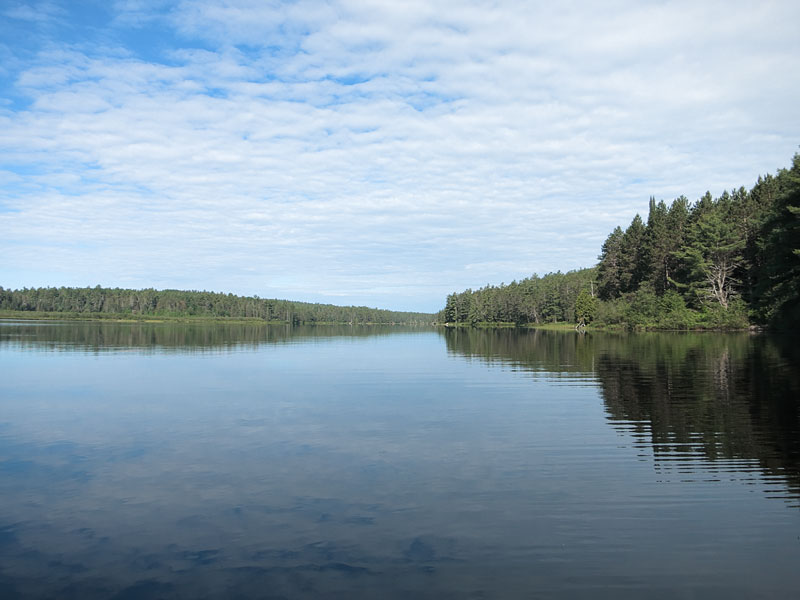
(photo by Diana: 2015-06-24 - map - explore)
Carcajou Lake looking west from out in front of our campsite.
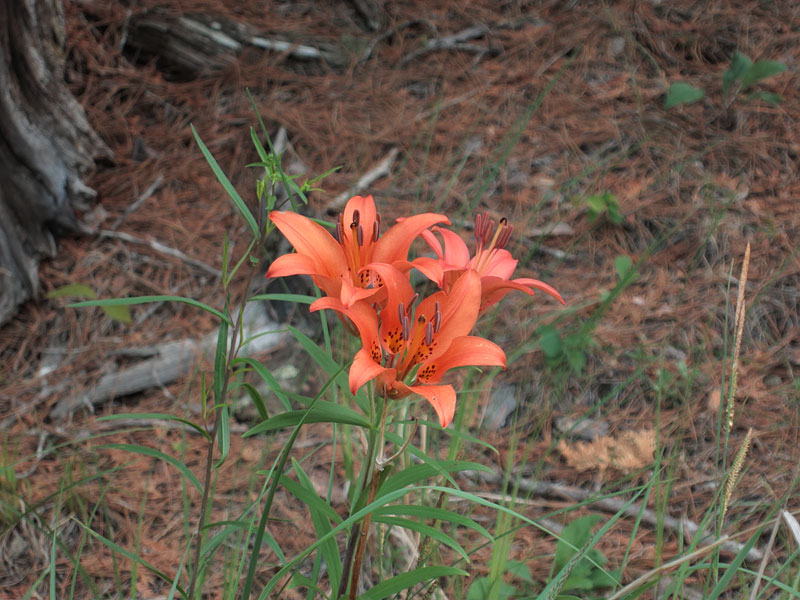
(photo by Diana: 2015-06-24 - map - explore)
Lilium philadelphicum, Wood Lily, on Carcajou Lake. This is not a rare wildflower, but in our experience, it is not often seen. We can only remember it from one other location.
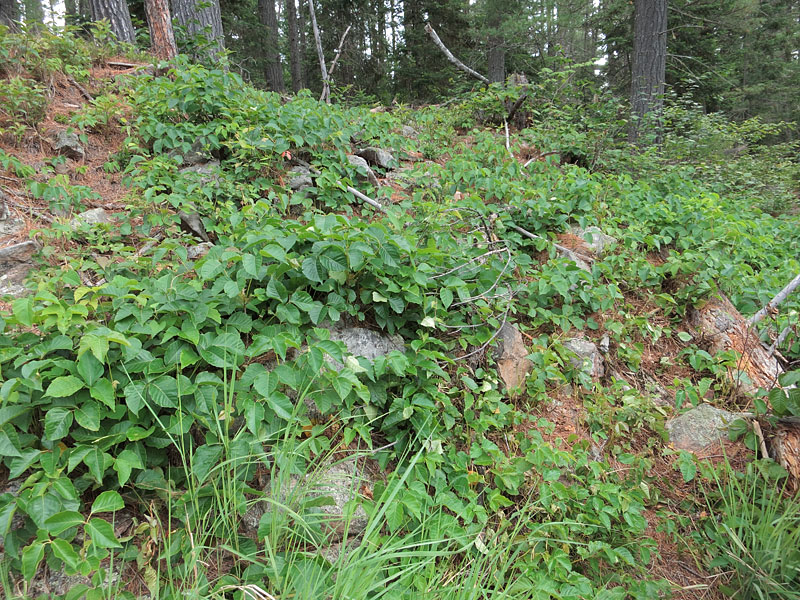
(photo by Diana: 2015-06-24 - map - explore)
Poison ivy on the portage into the sedge meadow. This is a large vigorous patch but it is very common along Carcajou Creek and then down the Barron River.
The top end of Carcajou is quite rugged with cliffs on both sides as befits an early glacial flow channel (with the controlling sill located in/near the sedge meadow).
We flushed a deer at the portage. Diana's best deer act had it confused for a while but it eventually figured us out.
The sedge meadow was interesting and different from most Algonquin wetlands in that there was little in the way of sphagnum and broadleaf bushes but – surprise – sedges instead. Pitcher plant, pogonia, sundews, water lilies, bladderwort, with a few cattails (starting to invade).
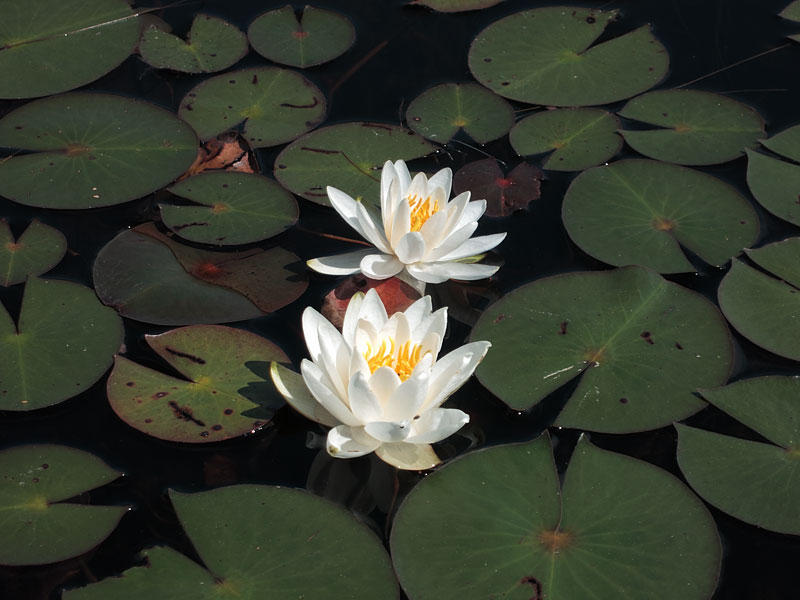
(photo by Diana: 2015-06-24 - map - explore)
White water lily in the sedge meadow on Carcajou Creek
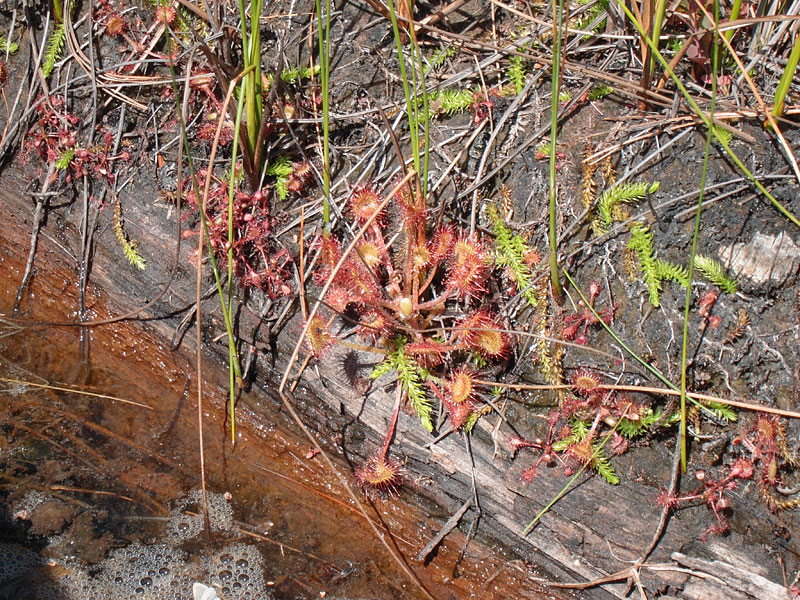
(photo by Bob: 2015-06-24 - map - explore)
Round leaf sundew in the sedge meadow on Carcajou Creek. I believe that it was at this location, 30+ years ago that I first started paying attention to sundews.
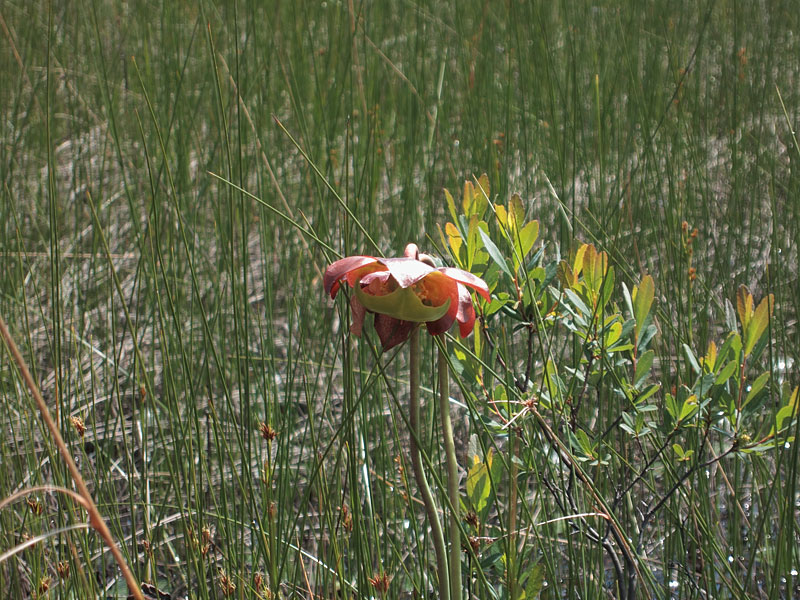
(photo by Diana: 2015-06-24 - map - explore)
Pitcher plant in the sedge meadow on Carcajou Creek
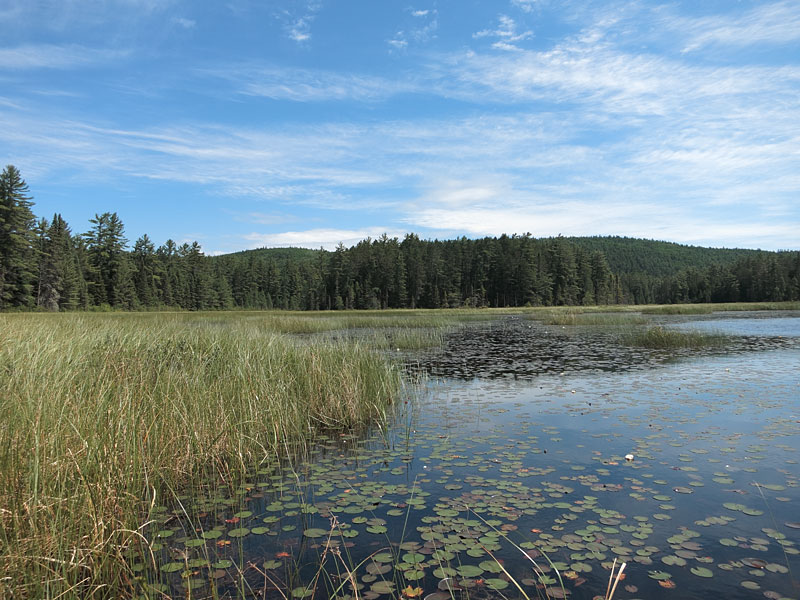
(photo by Diana: 2015-06-24 - map - explore)
In the sedge meadow on Carcajou Creek looking towards the hill line south of Grand Lake.
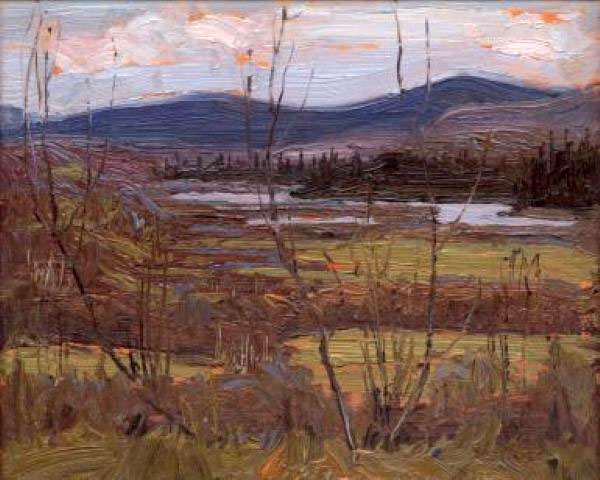
The Tom Thomson sketch, 'Algonquin Park Vista'. This sketch is believed to have been painted in 1916 which would suggest that its location is in the general vicinity of Achray. The landscape elements of the picture — foreground wetland / creek with somewhat distant relatively large hills — suggested to us that it was somewhere along MacDonald Creek / Carcajou Creek system with the background hills being the line of hills south of Clemow Lake, Grand Lake, Stratton Lake, etc. We interpret the painting as depicting a landscape essentially denuded of large trees.
Does the location match the painting? Probably not. The background hills are perhaps right, but the present tree growth hides the vista in the sketch. And [if it is the location] the present water level is much higher. However, the water level is controlled by a beaver dam. So you might be able to get a match in the absence of trees and beavers.
[We have subsequently found a location on lower Carcajou Creek that appears to be a more likely location; see addendum.]
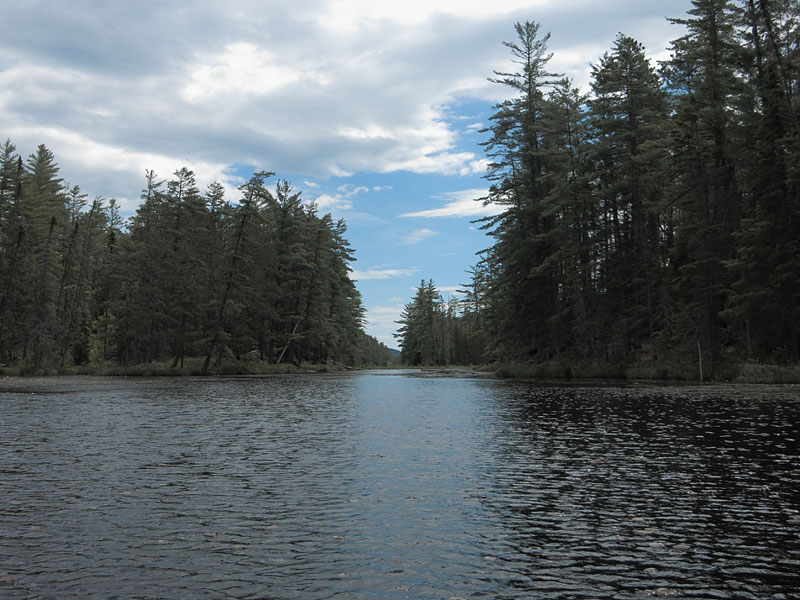
(photo by Diana: 2015-06-24 - map - explore)
Looking down towards Carcajou Lake from the sedge meadow on Carcajou Creek
As alluded to in the text , Carcajou Creek was an early glacial flow channel. Initially, Lake Algonquin reached inland to the controlling sill near White Partridge Lake with the outflow going down the Bonnechere River Valley. Once the glaciers receded sufficiently to uncover the current location of the sedge meadow, the glacial flow shifted to down the Carcajou Creek valley, into Carcajou Bay on Grand Lake and then down the Barron and Indian Rivers to the Champlain Sea. At a later date, the ice uncovered a sill above Clemow Lake and the flow shifted to straight down Grand Lake. And finally, when the Petawawa River valley was clear of ice, the flow shifted to there. This is described in more detail in our page The Mink Lake Sill and more definitively in M.J. Ford and R.S. Geddes (1986); Quaternary Geology of the Algonquin Park Area, Ontario Geological Survey, Open File Report 5600..
That Carcajou Creek was a glacial flow channel does much to explain the ruggedness of the area. The meltwater swept everything away leaving behind exposed bed rock and boulder pavement. An interesting comparison is between MacDonald Creek and Carcajou Creek. Both are symmetrically placed with respect to the line of hills south of Grand Lake, Stratton Lake etc and to Carcajou Bay. Carcajou Creek was a meltwater flow channel; MacDonald Creek was probably inundated with standing meltwater. Carcajou Creek is wild and rugged; MacDonald Creek is wild and "soft" (but still hard travelling).
On the way back to our camp site, we stopped and photographed the real wood pile I remember from 30 years ago – slab wood 4' lengths, piled in 2 rows – let's say 6' high and extending for perhaps 200' (eyeballing). That's in the range of 50 to 100 cords of firewood. Clearly part of the winter firewood supply for the lumber camp. Leaving it to rot is wasteful but not on the same scale as wasting full sized logs (which is what my faulty memory recalled).
[Diana: The wood in the pile seemed to be a mixture of slab wood and small cross-section rectangular pieces – looked like offcuts from a sawmill, the slabs from squaring up the logs and the rectangular pieces leftovers from cutting dressed lumber to size.]
We returned to camp at about 12:30 and had coffee. The wind is up again so not good conditions for exploring the long southern arm on Carcajou.
(We didn't go to Greenleaf because currently Diana has been trying to be nice to her knee; it has been complaining for the last several weeks).
Quiet afternoon. Wind rising and falling enough to preclude a pleasant exploratory paddle. Diana napped; Bob contemplated.
It is now 7:20. All is calm, food is up, and we are about to have our evening libation.
[Diana: supper was Alpinaire Pepper Beef with Rice – quite good.]
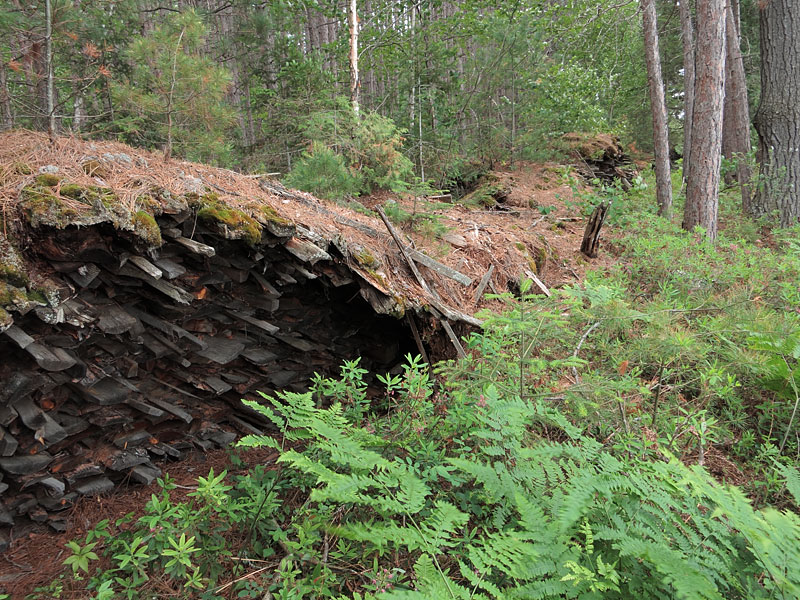
(photo by Diana: 2015-06-24 - map - explore)
Abandoned wood piles on Carcajou Lake.
2015 June 25 (Thursday) - Carcajou Lake to Little Carcajou Lake
Up at 6:15. Temp 8C. Morning clear, some high milky cloud, light mist on the water, wind calm. Quiet night.
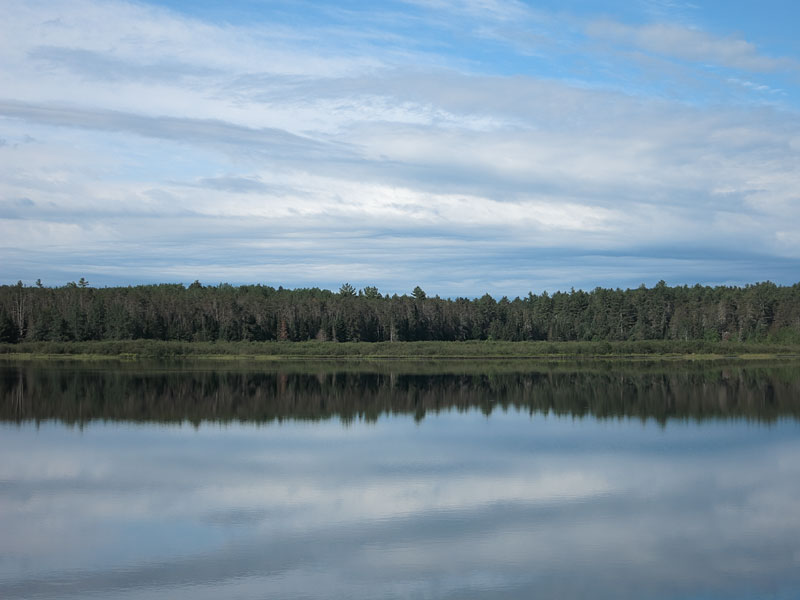
(photo by Diana: 2015-06-25 - map - explore)
Wetland on Carcajou Lake.
9:35 – in the canoe, off our camp site and ready to head out. Lake is almost glassy calm. Sun feels hot. Clouds some cirrus, some stratus.
Through the portage [Carcajou Lake to Carcajou Creek] @ 10:05. That portage is flat but very rough – boulder pavement as befitting a glacial drainage (like the portage below High Falls Lake, but rougher). The saving grace is that the boulders are firmly rooted and don't shift under foot.
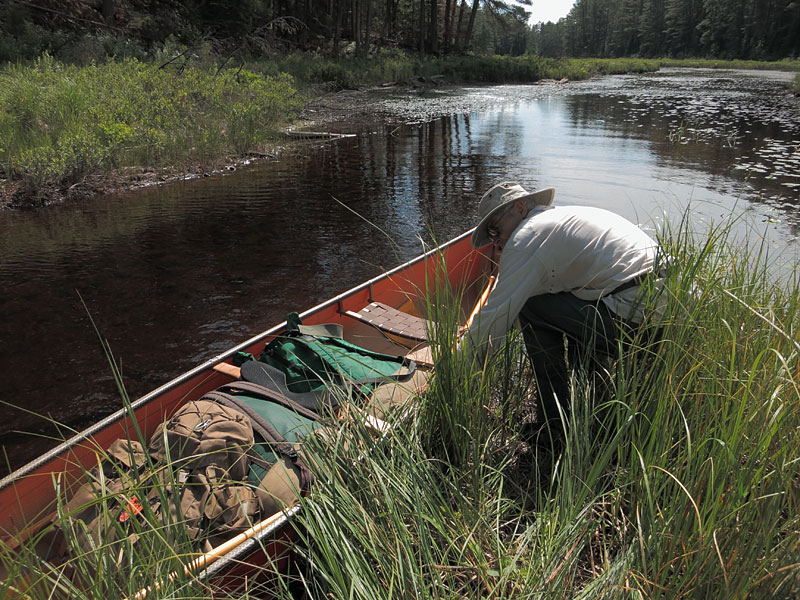
(photo by Diana: 2015-06-25 - map - explore)
Navigating Carcajou Creek. Here, Bob had just slid the canoe, fully loaded, across the grassy hummocks, in order to bypass a log completely obstructing the creek.
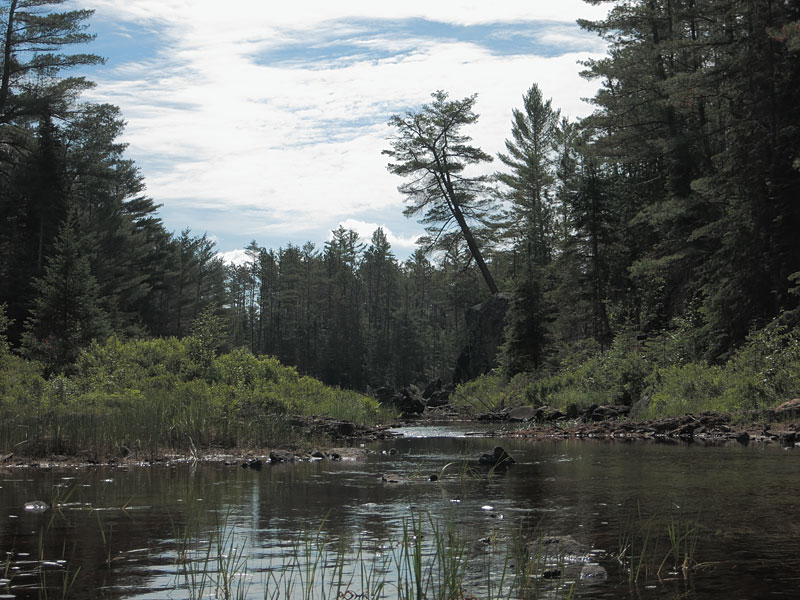
(photo by Diana: 2015-06-25 - map - explore)
Looking downstream on Carcajou Creek.
[We stopped at the old logging dam site in order to better evaluate whether this might have been the location of the Tom Thomson painting The Drive.]
- Some notes re the dam site:
- - there is a flat area on south shore above dam – perhaps something was there, but perhaps it was flooded
- - there is no doubt that this is a logging dam.
- - the dam extends about 20' into bush on south shore
- - the elevation of dam [was] about [the] top of [the] big rock – i.e. about 6' above current level
- - assuming this is the site, the painting location is now completely overgrown and the view is no longer available
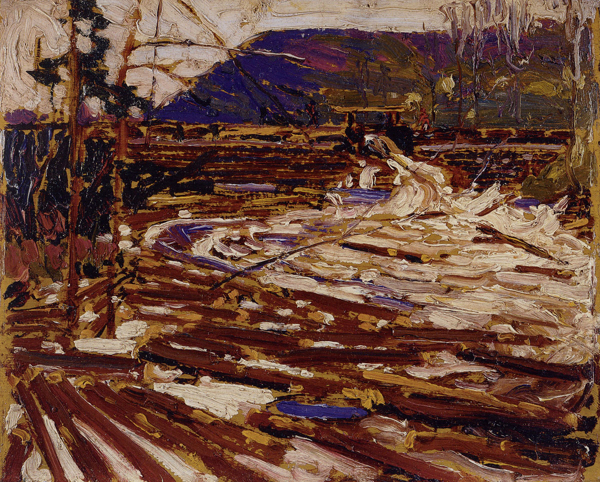
Log Jam: Sketch for 'The Drive'. This Tom Thomson sketch was painted in 1916 and the finished painting 'The Drive' that winter. The painting is generally thought to depict a J.R. Booth lumber drive on the 'Petawawa'. But where exactly? The problem is that at the obvious locations — the foot of Grand Lake or somewhere farther down the South Branch of the Petawawa (Barron River), for example — the background hills don't match. What is needed is high ground on the right hand shore (looking upstream) and low ground on the left hand shore. Carcajou Creek between Wenda Lake and Carcajou Lake matches this topography; we haven't been able to identify any other location in the Achray area that does. In addition, the background hill has a rather distinctive shape.
We had identified this tentative location through the topographical considerations described above and the knowledge that Carcajou Creek supported log drives as evidenced by the ruins of Stone Chute. We subsequently learned from 'MartinG' of the remains of an old logging dam at this location. We discussed this privately with several fellow canoeists. Later 'Peek' visited this location (twice) and believed that the location matched the painting.
However, Craig Lake on the South River has also been suggested as the location of this painting.
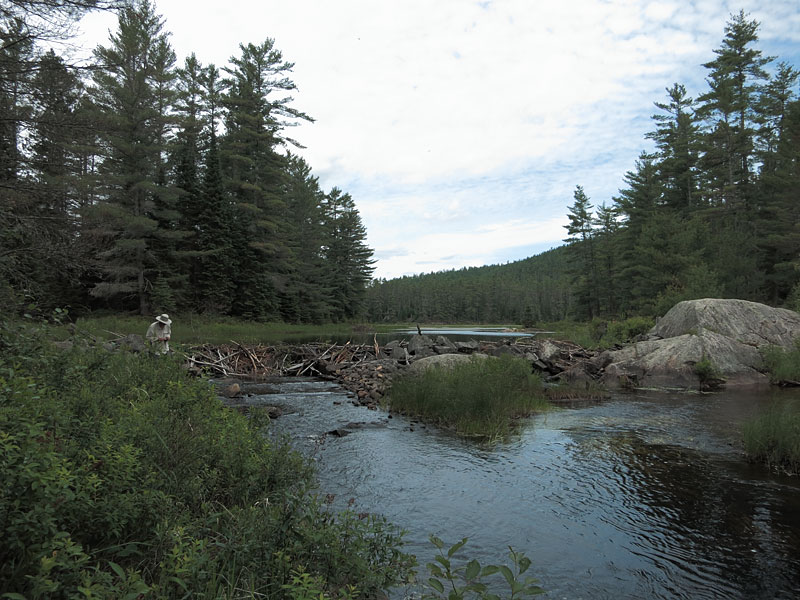
(photo by Diana: 2015-06-25 - map - explore)
The remains of the Old lumber dam on Carcajou Creek. It is now more of a beaver dam but there is no doubt that it formerly was a lumber dam (rock piles, old spikes, etc.)
Is this the lumber dam depicted in the painting? We believe that it may be. However, a certain amount of 'hand waving' is necessary to make the case. Most importantly, the background hill — although not well shown in this photo — is appropriately shaped and is in the correct location relative to the dam. However, to match the hill to the painting, you need to assume that Thomson purposely exaggerated the verticality. He may also have exaggerated the height of the dam. This sort of exaggeration to increase drama of the painting occurs in many of Thomson's works.
The actual view depicted in the painting is no longer available; the painting location is completely overgrown.
4:30 Sitting in our bug net on Little Carcajou Lake. Camp is all set up. We've had coffee and afternoon snacks.
Sky is overcast and wind calm. I suspect rain.
We are both tired. More tired perhaps than we have any right to be given how far we've come. But travelling Carcajou Creek is hard, rugged work and the day is warm and muggy.
We stopped at the cabin. The couple seemed in good spirits. However the woman is still having trouble walking more than 100m or so and the man was complaining of an infected foot. In retrospect, I suspect poison ivy (which is everywhere back in here). Their plan is to leave the cabin first thing Sunday morning with the goal of reaching Achray that day. The man will carry everything (3 loads) while the woman will hobble along empty. If they can't make it all the way to Achray, they will simply camp where they can. If it is raining on Sunday they will delay until Monday but they won't delay beyond Monday.
[They had a plan that they were comfortable with and Diana and I didn't see that there was anything we could reasonably do to assist; we were travelling on quite different schedules. We considered mentioning the situation to the rangers at Achray, but without a specific immediate problem to address — only hypothetical future difficulties — we didn't think that they would show much sympathy or interest.]
We'll never know what happened!
8:55 Sitting in our bug net with our Bushmills. Everything is calm and quiet except for the bullfrogs. The sun is just about to go down. The incessant whine of the mosquitoes has not yet begun.
[Diana: supper was Alpinaire three cheese lasagna. I had not noticed when buying it that it was a four-person dinner, and it was huge. Fortunately (?) I managed to spill about half of it while serving, so we ended up having about the right amount, and it was tasty, too. Didn't enjoy the cleanup so much. Won't make that mistake again.]
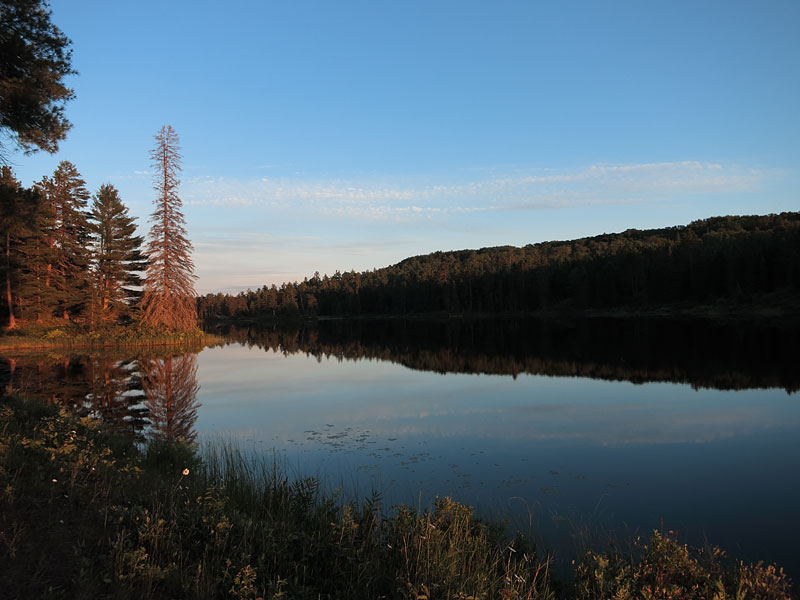
(photo by Diana: 2015-06-25 - map - explore)
Evening on Little Carcajou Lake.
2015 June 26 (Friday) - Little Carcajou Lake to Achray
Out of the tent at 6:00 am – 8C. Sky clear – mist with morning breezes.
On the water @ 9:15. Mist has risen, sky still clear, light breeze from the west. Going to have a look at Stone Chute.
[Diana: Stone Chute was interesting – remains (rocks only) of a dam with sluiceway and a log flume along the west shore. No evidence of any timbers remaining. Stunning rocky landscape with a good supply of poison ivy.]
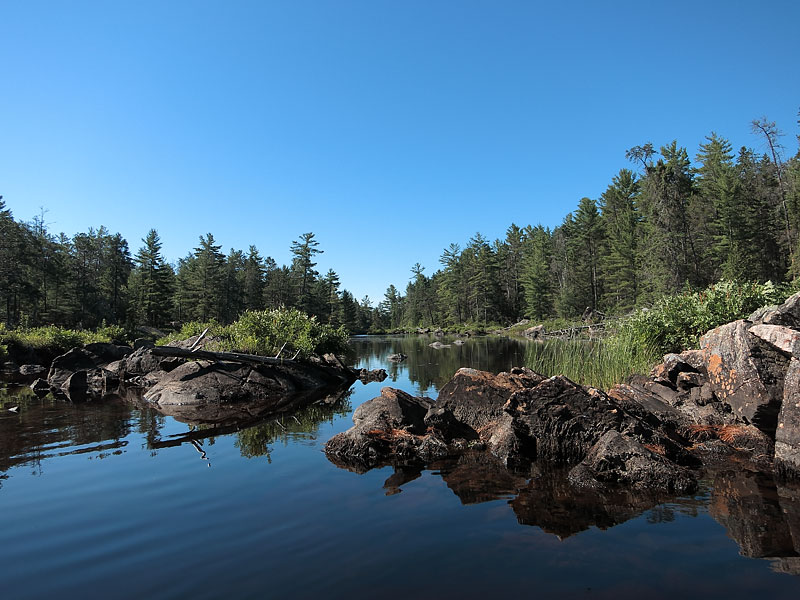
(photo by Diana: 2015-06-26 - map - explore)
Heading towards Stone Chute on Carcajou Creek.
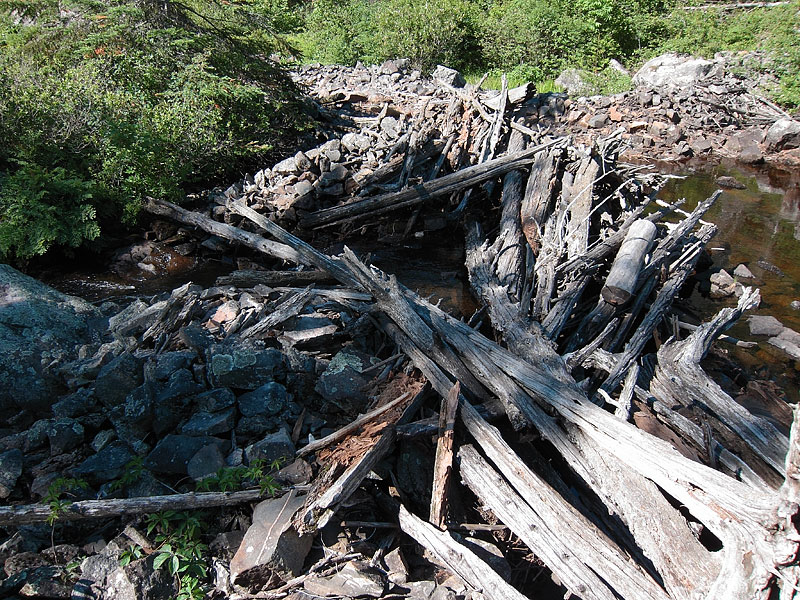
(photo by Bob: 2015-06-26 - map - explore)
Remains of the logging dam at Stone Chute on Carcajou Creek. All that is left are piles of rocks that formed the dam, sluiceway and chute; the nest of timbers appears to be just a collection of dead trees that have been piled there by the current. The flow is from right to left. The sluiceway is in the centre of the photo. In the background along the far shore are the remains of a chute.
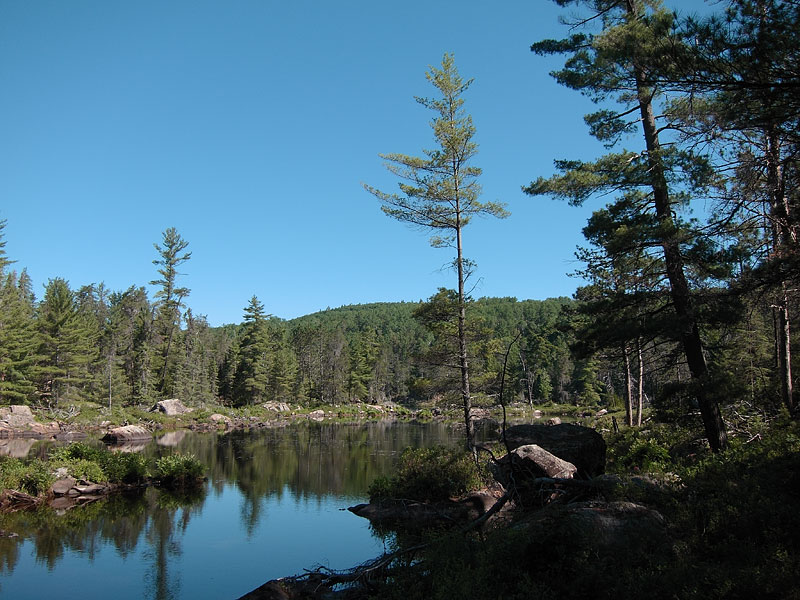
(photo by Bob: 2015-06-26 - map - explore)
Looking back towards Little Carcajou Lake from Stone Chute
We started through the portage [Little Carcajou to Upper Spectacle] at ~10:00 and finished at 12:15. We paddled the pond without issue. Had lunch while drifting about on Upper Spectacle Lake.
[Diana: Even at the dropping water levels we experienced, the pond was quite deep enough for our canoe with a full load. A bit shallow landing at the east end. Worth the extra loading and unloading to avoid a very rough section of trail.
I fell not far beyond the beaver pond, landing hard on a rock with my bad knee. After some wailing and cursing, lying on the trail, I got out of the pack straps, managed to stand up, hoisted the pack onto my back and carried on. Knee worked until Achray, seized up completely during the drive home. After a couple of colourful days (bruises, abrasions) it seems to be settling down and is functional, if not entirely comfortable.]
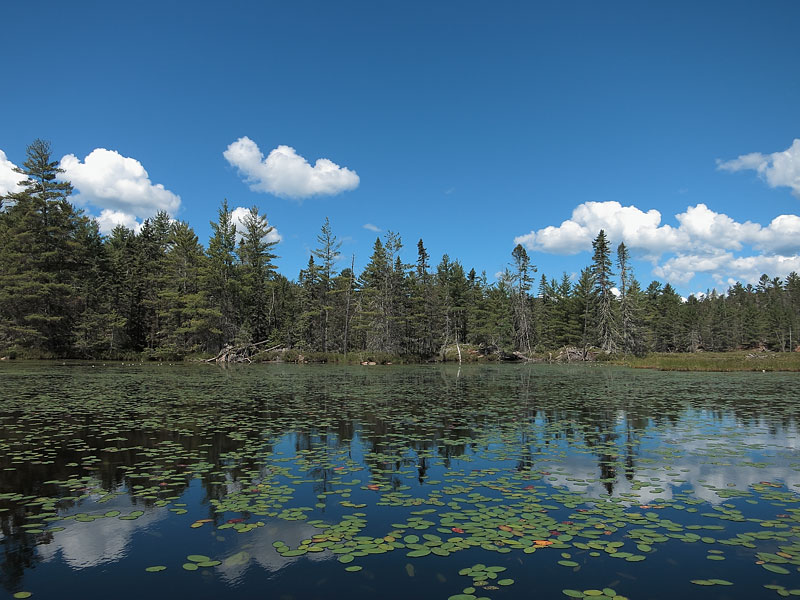
(photo by Diana: 2015-06-26 - map - explore)
Beaver pond on the portage between Little Carcajou Lake and Upper Spectacle Lake.
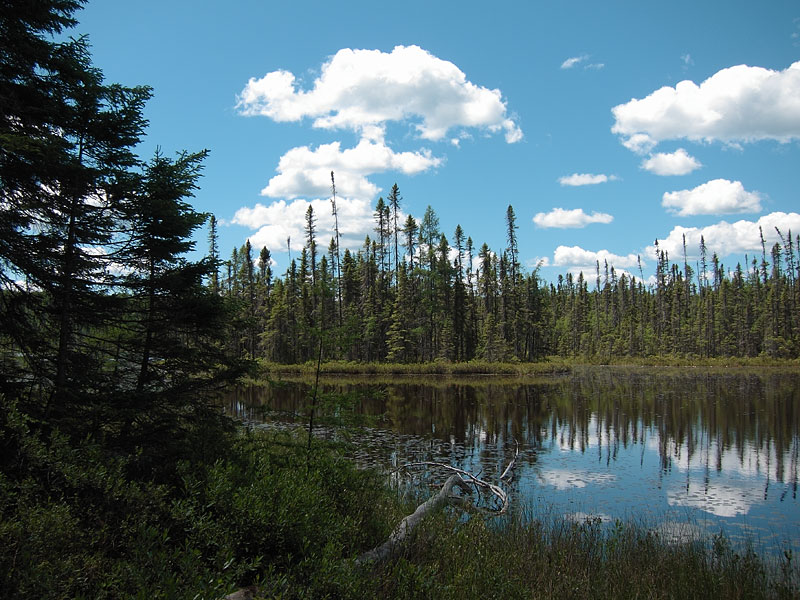
(photo by Bob: 2015-06-26 - map - explore)
Upper Spectacle Lake as seen from the end of the portage. The far shore has a very 'boreal forest' look to it.
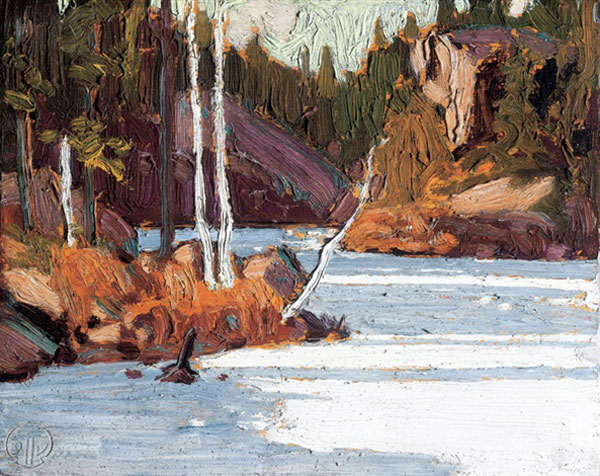
In Petawawa Gorges, Spring, a sketch by Tom Thomson. There is a pencil inscription on the reverse that has been attributed to Dr. James MacCallum and reads, in part, "Ice still present toward middle of April. Painted near mouth of Petawawa from Achray, Grand Lake." However, the actual location of this painting has been a ongoing mystery to us.
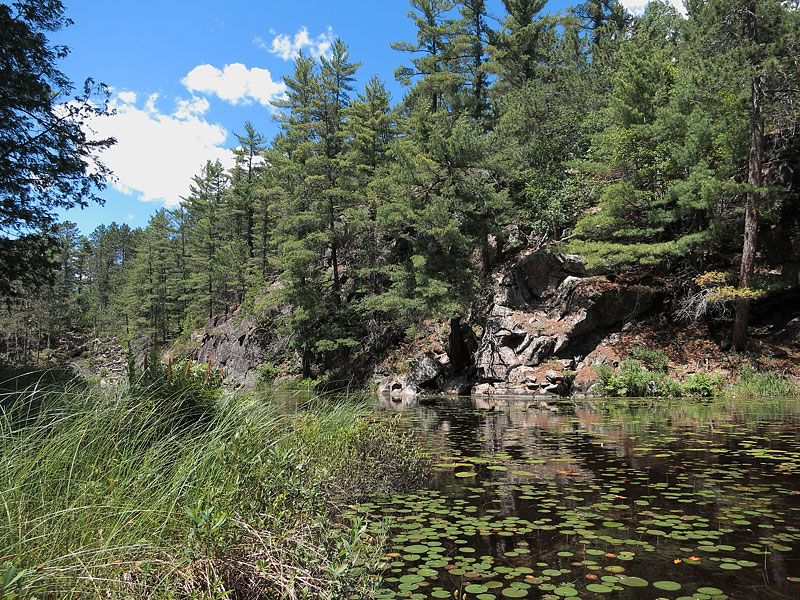
(photo by Diana: 2015-06-26 - map - explore)
Narrows between Carcajou Creek and Lower Spectacle Lake. While not obvious from the above photograph, we are reasonably convinced that this is the location of the above painting. We will return to take a more convincing photo next spring before the vegetation returns. (It is not obvious from the photo that there is a small bay behind the near cliff on the far shore as in the painting. Also, in Thomson's time there would have been a dam at Carcajou Falls and thus the water level depicted in the painting would differ from the modern level. This photo was taken from our canoe; the painting location is no doubt up on the shore.)
This location is consistent with MacCallum's description of the location. By "Petawawa", MacCallum no doubt meant the Barron River which was then known as the South Branch of the Petawawa River. The modern convention is that the Barron River flows out of Clemow Lake into Grand Lake. However, it is not difficult to believe that MacCallum was referring to Carcajou Creek as the Petawawa. The watercourse between Carcajou Falls and Lower Spectacle Lake is not on Carcajou Creek, but is "near" its mouth.
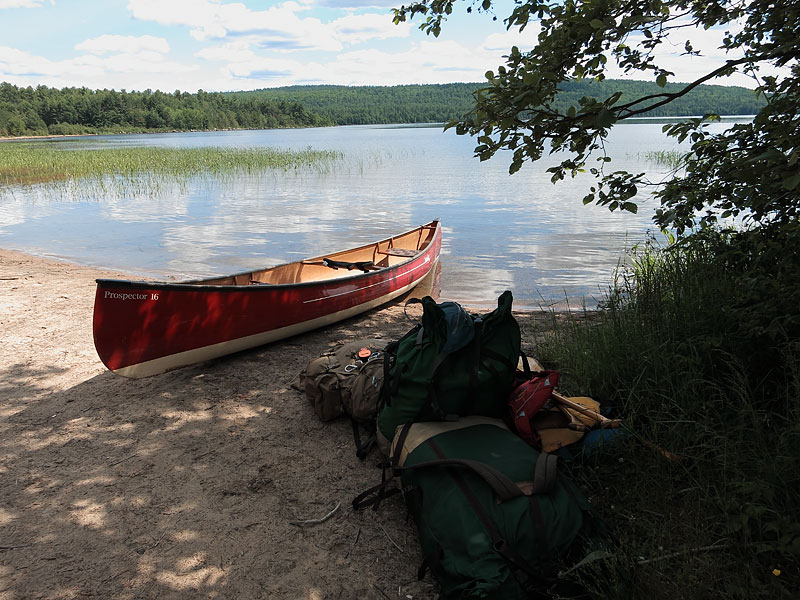
(photo by Diana: 2015-06-26 - explore)
All done — back on the beach at Achray.
[Diana: Straightforward portage into Lower Spectacle Lake. There were two people at the south shore camp site and a solo paddler fishing in the middle of the lake. It seemed odd after having seen only two other people (albeit three times) for the previous five days. Took a few photos in the gut to Carcajou Creek, then did the two portages around the falls. Carried over the rock at 'Peek's Peril'. Stopped in the bay to pump water, eat snacks, etc., and also to rest – we both feel a bit tired.
Light wind, so relatively easy paddle across to Achray, landing around 4:00. Passed through a flotilla of canoes filled with women and children heading out as we came in.
Saw a mother bear and two very small cubs on the road to the gate. Home before 6:00.]
Addendum - 2015 July 27
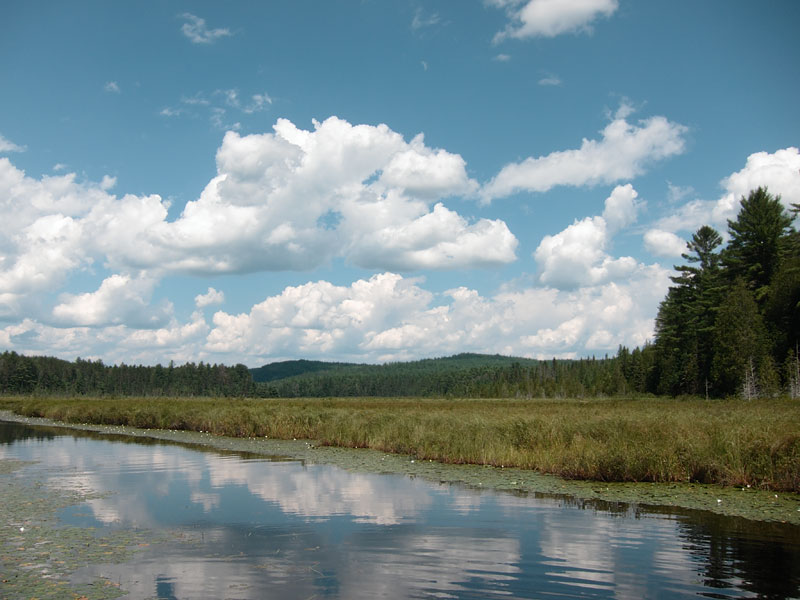
(photo by Bob: 2015-07-27 - map - explore)
Subsequently we have discovered this view on the lower part of Carcajou Creek. This view is looking north on Carcajou Creek from somewhat south of the mouth of McDonald Creek. The background hills provide a reasonable match to those in the painting "Algonquin Park Vista". We are now inclined to believe that the painting is of this general area, but the exact location is not findable due to the regrowth of the forest. That is, the painting is from a more elevated position but the adjoining hillsides are now all tree-covered.
Notes
Our food strategy. We realized on the basis of past experience that previously, our tripping diet tended to be deficient in protein. In addition we realized that even in our day-to-day living our sodium intake tended to be low. But on a strenuous canoe trip, your salt intake needs to increase. Consequently the high sodium content of Cup A Soup etc. and freeze dried meals is a plus, not a minus. Embrace them. And they use minimal fuel to "cook". On this trip the only "cooking" involved boiling water on our Trangia to add to instant soup, freeze-dried meals, coffee and granola. If we assume that we require three to four thousand Calories per day, then a freeze-dried dinner only provides a small proportion of the day's calories. Therefore we focused on our snacks — cheese, oat cakes, gorp, Mahatten Mix, protein bars, and homemade squares and brownies — to provide the bulk of our day's calories (lunch is a glorified snack). Breakfast is a high-calorie granola and cheese. Two protein bars per day can contribute 40g protein. Thus we focused on breakfast and snacks and the freeze-dried dinner was more a token dinner than a crucial part of our daily nutrition. This strategy worked well for us but would not suit all. Freeze-dried dinners are bulky and expensive. In warmer weather and late sundown, we are fine with no fire; others may not be.
